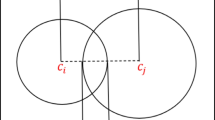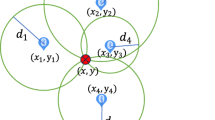Abstract
It is gradually more significant to optimally select base stations in the design of cellular networks, as the customers stipulate cheaper and better wireless services. From a set of prospective site locations, a subset needs to be preferred which optimizes two critical objectives: service coverage and financial cost. Discovering the optimum base station locations for a cellular radio network is considered as a mathematical optimization problem. In the context of mobile communication, an efficient algorithm for the base-station placement problem is developed in this paper. The intention is to place a given number of base-stations in a given convex region and to assign range to each of them such that every point in the region is covered by at least one base-station and the maximum range assigned is curtailed. It is basically covering a region by a given number of equal radius circles where the objective is to minimize the radius. A computational method for finding good coverings of a square with equal circles is presented. An algorithm is designed that determines the optimal locations of base stations without performing an exhaustive search. The proposal will try to minimize the number of installed towers, makes tower’s location feasible, and provides full area coverage with an intention to reduce the overlapping.









Similar content being viewed by others
References
Whitaker, R. M., Raisanen, L., & Hurley, S. (2004) . A model for conflict resolution between coverage and cost in cellular wireless networks. In Proceedings of the 37th Hawaii international conference on system sciences - 2004, 2004 IEEE.
Mathar, R., & Niessen, T. (2000) . Optimum positioning of base stations for cellular radio networks. Wireless Networks 6, 421–428 421, Aachen University of Technology, D-52056 Aachen, Germany.
Dorne, R., & Hao, J.-K. (1995) . An evolutionary approach for frequency assignment in cellular radio networks. In Proceedings of IEEE international conference on evolutionary computation, volume 2, pp. 539–544. WA, Australia: Perth.
Das, G. K., Das, S., Nandy, S. C., & Sinha, B. P. (2006) . Efficient algorithm for placing a given number of base stations to cover a convex region. Journal of Parallel and Distributed Computing 66, 1353–1358, Indian Statistical Institute, Kolkata 700 108, India.
Nguyen, V. M., Baccelli, F., Thomas, L., & Chen, C. S. (2010) . Best signal quality in cellular networks: Asymptotic properties and applications to mobility management in small cell networks. Hindawi Publishing Corporation EURASIP Journal on Wireless Communications and Networking, volume 2010, Article ID 690161.
Wu, Y., & Pierre, S. (2007). Mobile radio network planning aspects. Networking and Communications (WiMob: Third IEEE International Conference on Wireless and Mobile Computing.
Raisanen, L., Whitaker, R. M., & Hurley, S. (2004). A comparison of randomized and evolutionary approaches for optimizing base station site selection. Department of Computer Science Cardiff University Queen’s Buildings, The Parade Cardiff, CF24 3XF, U.K. 2004 ACM Symposium on Applied Computing, SAC 04, March 14–17, Nicosia, Cyprus.
Raisanen, L., Whitaker , R. M., & Hurley, S. (2003). Mu1ti-objective optimization in area coverage problems for cellular communication networks: Evaluation of an elitist evolutionary strategy. Department of Computer Science, Cardiff University Queensland Queen’s Buildings, The Parade Cardiff, CF24 3XF, U.K., Me1bourne, Florida, USA.
Danesfahani, R., Razzazi, F., & Shahbazi, M. R. (2009). An active contour based algorithm for cell planning. In Proceedings of ICCTA2009, 978–1-4244-4817-3/09/${\$}25.00 \copyright $ IEEE.
Hussain, S. A., Emran, M., Salman, M., Shakeel, U., Naeem, M., Ahmed, S., & Azeem, M. (2007). Positioning a mobile subscriber in a cellular network system based on signal strength. IAENG International Journal of Computer Science, 34:2, IJCS $34\_2\_13$, Advance online publication: 17 November).
Chu, H.-C., & Jan, R.-H (2002). Cell-based positioning method for wireless networks. In Proceedings of the 9th international conference on parallel and distributed systems (ICPADS’02) 1521–9097/02 \({\$} 17.00 {\copyright }\) IEEE.
AL-Hamami A. H., & Hashem, S. H. (2011). Optimal cell towers distribution by using spatial mining and geographic information system. World of Computer Science and Information Technology Journal (WCSIT) ISSN: 2221–0741 1(2), pp. 44–48. 44 . Jordan Iraq: Amman Arab University for Graduate Studies University of technology Amman.
Roya, S., Bardhanb, D., & Das, S. (2008). Base station placement on boundary of a convex polygon. Journal of Parallel and Distributed Computing, 68 (2008) 265–273, www.elsevier.com/locate/jpdc.
Bose, R. (January 2001). A smart technique for determining base-station locations in an Urban environment. IEEE Transactions on Vehicular Technology, 50(1).
Steven, C., & Samuel, P. (2005). Design problem of cellular wireless networks. Wireless Networks 11, 489–496, Springer Science and Business Media. Manufactured in The Netherlands: Inc.
Saunders, S., Carlaw, S., Giustina, A., Bhat, R. R., Rao, V. S., & Siegberg, R. (2009). Femtocells: Opportunities and challenges for business and technology. New York, NY, USA: Wiley.
Author information
Authors and Affiliations
Corresponding author
Rights and permissions
About this article
Cite this article
Singh, W., Sengupta, J. An Efficient Algorithm for Optimizing Base Station Site Selection to Cover a Convex Square Region in Cell Planning. Wireless Pers Commun 72, 823–841 (2013). https://doi.org/10.1007/s11277-013-1044-9
Published:
Issue Date:
DOI: https://doi.org/10.1007/s11277-013-1044-9




